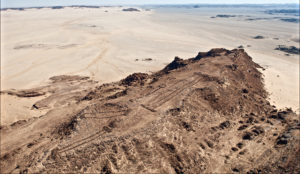
Most archaeologists would say that the Neolithic, a time period between 10,000–4,500 BCE, was best characterized by the beginnings of agriculture and fixed human settlements. These people were not known for their massive architectural achievements and monuments. But a recent excavation led by a team of archaeologists from the University of Western Australia has shed new light on ancient monumental structures dating back over 7,000 years ago, located in present-day Saudi Arabia.
Known as “mustatils,” named after the Arabic word for rectangle, these structures have been the subject of very little research, despite the fact that they are not a recent discovery.
“We started excavating in 2019 as it was the natural progression of our work in the region,” explains Dr. Melissa Kennedy, one of six researchers working on this excavation. “Once we had found out how these structures were formed it was important to be able to date them.”
The team documented hundreds of mustatils aerially, explored almost 40 on the ground, and excavated one, making this the largest study ever conducted on these structures. According to the project’s director Dr. Hugh Thomas, in an interview for Antiquity, over 1,000 mustatils were documented during this project, covering over 200,000 km2 in northwest Arabia.
Dr. Kennedy notes, “Our project started off as purely aerial photography and after viewing our photos of these structures we began to realize that these features were extraordinarily well preserved and that we needed to visit them on the ground. That is when we really began to realize how complex these structures were. Having the aerial photography component of our project is unique, as this allows us to get a different perspective on the archaeological remains we are documenting.”
“We use a variety of techniques; remote sensing, using publicly available satellite imagery, aerial photography, ground survey, and traditional excavation,” she explains. “We also used a lot of digital technologies, such as orthophotography, which is a highly accurate photo mosaic created from hundreds of aerial photographs, and drones. The main challenge with this site is that the structure was made of a type of stone that was highly degraded. It made work in the head of the structure very difficult and very hard to define the chamber.”
______________________________
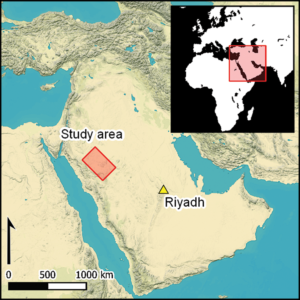
Map showing location of study area in Saudi Arabia. AAKSAU
______________________________
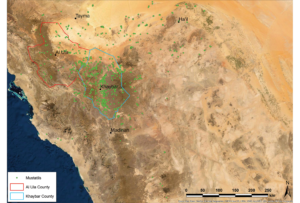
Mustatil distribution across northwestern Arabia. AAKSAU
______________________________
This research has more than doubled the total known number of mustatils in Saudi Arabia and established that these structures were far more architecturally complex than previously supposed. Cattle horns and skull parts were uncovered at the site as apparent offerings, confirming assumptions that the structures were built for rituals. Cattle was a vital part of the lives of early humans in the region. Evidence of ‘cattle cults’ have been found in southern Arabia around 900 years later, making it reasonable to conclude that these more ancient mustatils may have been an early example of these cults.
The number and consistency of mustatils in northwest Arabia suggests to researchers that these beliefs were widespread across the region. Given their size and number, they were likely large groups of people coming together and organizing to erect these ritual sites, creating the oldest monumental landscape of this scale ever identified, predating the pyramids of Egypt and Stonehenge in Britain.
“We hope to gain a broader insight into the cultic landscape of northwest Arabia in the late Neolithic,” says Dr. Kennedy. “Particularly, why were these large cultic structures built, what were the beliefs of these people and why did this tradition die out?”
____________________________
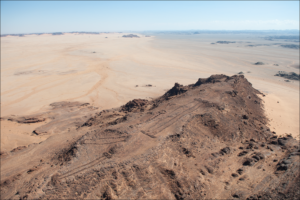
A group of three mustatils. AAKSAU and Royal Commission for AIUIa
____________________________
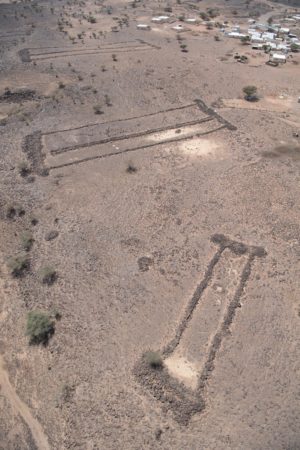
Mustatils from the Harrat Kaybar, Saudi Arabia. AAKSAU and Royal Commission for AIUIAa
____________________________
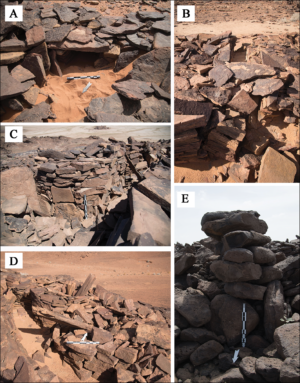
Features of a mustatil: (A) Internal niche located in the head of mustatil; (B) a blocked entranceway in the base of a mustatil; (C-D) associated features of a mustatil: cells and orthostats; (E) stone pillar identified on the Harrat Kaybar lava field. AAKSAU and Royal Commission for AIUIa
____________________________
While the findings of the excavation shed light on the ritual traditions and community organization of this region, they also offer more information on the wildlife at the time. Dr. Kennedy explains, “The animal horns are extraordinarily well preserved; they are very important as they give us an insight into the type of cattle being herded in the region in a way that the bones do not.”
“From our perspective, the most significant finds from our work have been from the mustatil and the collective burial we excavated that featured the earliest domestic dog in Arabia,” notes Dr. Kennedy. “For the mustatil, articulating the different facets of these structures has been very important. With the collective burial, we identified multiple phases of use and significant animal offerings. This is some of the earliest evidence for this in northwest Arabia.”
_____________________________
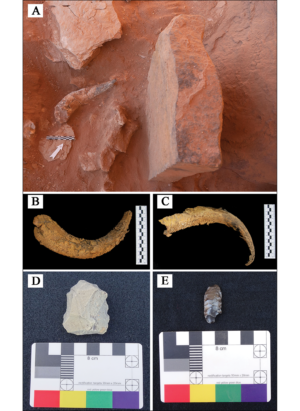
Artifacts recovered during excavation and ground survey: (A) cattle horn positioned in front of a betyl; (B-C) recovered cattle horns; (D) collected Neolithic micro core; (E) Neolithic bifacial foliate. AAKSAU and Royal Commission for AIUIa
_____________________________
Excavations at this mustatil site have concluded, but the team hopes to begin at another mustatil site in the near future to compare their results.
_____________________________
*Thomas, H., Kennedy, M., Dalton, M., McMahon, J., Boyer, D., & Repper, R. (2021). The mustatils: Cult and monumentality in Neolithic north-western Arabia. Antiquity, 95(381), 605-626. doi:10.15184/aqy.2021.51 https://doi.org/10.15184/aqy.2021.51
All images: http://creativecommons.org/licenses/by/4.0/
_____________________________
Advertisement



